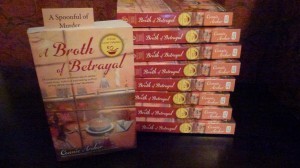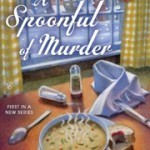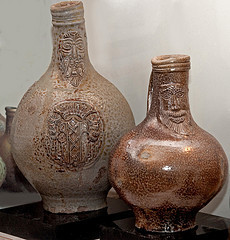Connie Archer's Blog, page 9
April 15, 2013
Witch Balls
Stop by the Dames of Dialogue to read Connie’s guest blog about Witch Balls, a New England tradition.
April 7, 2013
Mystery Lovers Kitchen
Stop by Mystery Lovers Kitchen today, April 6, 2013, where I’m guest blogging about one of my favorite soups.
April 2, 2013
The Missing
I’m guest blogging today at Melissa’s Mochas, Mysteries and More about the missing of Vermont. Hope you can stop and visit!
Release Day for A Broth of Betrayal
February 10, 2013
Snowbound Soup
This recipe is offered to anyone left snowbound and hungry in the wake of recent storms — hopefully you have power for cooking.
Where I am, I can’t complain too much, but still, it’s cold, it’s raining and there’s nothing I want more right now than a pot of soup, something thick, hot and bubbling. Only one problem, I haven’t been to the market and the refrigerator is virtually empty. Well, empty except for a couple of carrots, two limp stalks of celery, half an onion and a potato growing eyes. I opened and shut the vegetable drawer a few times, but nothing new appeared . . . I still wanted soup though. I rummaged around in the cupboard and here’s what I came up with.
 Snowbound Soup
Snowbound Soup
1 tbl. Butter
½ onion, chopped
2 cans diced tomatoes
2 cups vegetable bouillon
1 potato cut into small cubes
2 stalks celery
2 carrots, chopped
1 can corn
1 can beans (any kind)
Sauté the chopped onion in butter in a large pot.
Puree the diced tomatoes with a wand or in a blender. Add the tomato mixture to the pot.
Add 2 cups of vegetable broth (or bouillon).
Add chopped potato, chopped celery, chopped carrots, then add 1 can of corn (with liquid) and 1 can beans (with liquid).
Simmer for 15 or 20 minutes until the carrots and celery are soft.
Serves 4
Hardly gourmet cooking, but it hit the spot!
January 17, 2013
Widow’s Walks
I was very young the first time I saw a widow’s walk on top of an old house somewhere in Boston where I grew up. I remember staring at the banisters for a long time, wondering why anyone would ever want stairs on a roof.
I was told this perch was a widow’s walk created for women waiting for their men to return from the sea. I was enchanted. I imagined a beautiful woman with long full skirts, a lace bodice, the wind blowing through her hair, pacing back and forth, anxious for her lover to return home. Such a romantic notion! Of course, the sad truth was that many did not return, so perhaps the name was apt.
The dictionary tells us a widow’s walk is a railed, rooftop platform typically built on a coastal house, and originally designed to observe vessels at sea. Wikipedia says a widow’s walk was also known as a “widow’s watch, or captain’s walk and the name is said to come from the wives of mariners, who would watch for their spouses’ return, often in vain as the ocean took the lives of their men.”
 I’ve always believed widow’s walks were a particularly New England device, but I’ve found them in many places, open and enclosed. Here’s one in San Francisco. Perhaps a slice of the sea is still visible from its location.
I’ve always believed widow’s walks were a particularly New England device, but I’ve found them in many places, open and enclosed. Here’s one in San Francisco. Perhaps a slice of the sea is still visible from its location.
Here’s another in St. Helena, California – wine country, not a wave in sight, well, not unless you travel a good number of miles due west. Was it simply an architectural trifle carried from the east coast, or built to watch the laborers working in the vineyards?
Wikipedia goes on to explain that widow’s walks were a standard feature of Italianate architecture, very popular in North American coastal communities, a variation of the Italianate cupola also known as a belvedere, a high maintenance device prone to leaks. Since they were frequently built around a chimney, their real use was to allow access to pour sand down a burning flue in case of fire.
 Roof leaks? Sand? Chimneys? No! I don’t believe that for a minute! I still see that lonely woman gazing out hopefully over the sea, praying for her lover’s return.
Roof leaks? Sand? Chimneys? No! I don’t believe that for a minute! I still see that lonely woman gazing out hopefully over the sea, praying for her lover’s return.
November 20, 2012
Blog Hop – The Next Big Thing
I’m excited to be hosting Kathleen George on my blog today. She’s graciously agreed to take part in the Blog Hop – “The Next Best Thing.” Kathleen is the author of eight books: Simple, Hideout, Pittsburgh Noir, The Odds, Afterimage, Fallen, Taken and The Man in the Buick. I can’t wait to read her next book and soak up some Pittsburgh noir! Read on and learn what Kathleen is up to now.
What is the working title of your book?
Blood.
Where did the idea come from for the book?
A relative with a health problem that I turned into a murder!
What genre does your book fall under?
Police thriller/police suspense.
Which actors would you choose to play your characters in a movie rendition?
Gabrielle Byrne, Melissa George.
What is the one-sentence synopsis of your book?
The police try to place an orphaned boy with a good family and when he disappears, they have to figure out who his father (the only suspect they have) actually is.
Will your book be self-published or represented by an agency?
Hopefully neither. Hopefully straight to editor. Will keep you all posted.
How long did it take you to write the first draft of your manuscript?
Eighteen months.
What other books would you compare this story to within your genre?
I don’t have much sense of that. Sorry.
Who or what inspired you to write this book?
Things my husband said. One of them is what he says every time he is leaving the house. “And so I’m leaving.” That was the working title for a while but I already know that not only are there too many similar titles but that no editor is going to consider that an okay title for a police thriller. They’re going to want something close to . . . Blood.
What else about your book might pique the reader’s interest?
Characters I really care about, people, fictional yes, who make me cry when I write about them.
Thank you, Kathleen, for stopping by the Blog Hop. We’re all looking forward to Blood!
November 14, 2012
Blog Hop – The Next Big Thing
Every author wishes his or her book could be The Next Big Thing and since I’m writing soup shop mysteries, I’ve thought of titling the next one Fifty Shades of Stew . . . or maybe not!
Seriously, if any author could predict the next zeitgeist in fiction, wouldn’t he or she be the lucky one? I’ve always loved Bram Stoker’s Dracula, and as we all know, Bela Lugosi (and Christopher Lee) brought Stoker’s unforgettable character to life. In spite of that, I could never have predicted the current flurry of vampires, wraiths, graywalkers and shapeshifters, or alternate realities our protagonists inhabit – willingly or unwillingly.
Every book we open can lead us into an alternate reality. In the soup shop series, my imaginary reality is a small village in Vermont called Snowflake where I hope the characters and their stories will come to life and live and breathe for each reader.
Read on to see my answers to the ten questions posed. Comments and questions are very welcome. Then move on to visit and explore other authors’ websites and blogs. Hopefully this Blog Hop will introduce you to characters you haven’t yet met or perhaps haven’t been to visit for a while.
Special thanks goes to Linda O. Johnston for inviting me to this Hop. You can check out her blog at Killer Hobbies. And happy travels through the websites and blogs of my guests below.
What is the working title of your book?
I’ve just finished working on the third book in the soup shop mystery series. I refer to this one as Spoonful #3, since all the action takes place at the By the Spoonful Soup Shop in Snowflake, Vermont. The first book, A Spoonful of Murder was released in August 2012, and the second, A Broth of Betrayal, will be released in April 2013. I do have a list of possible titles for Spoonful #3, pending the publisher’s approval. At the top of that list is Parsley Sage Rosemary and Crime. Another possible title is Revenge in the Roux. Of course, Spoonful #3 may be called something else entirely by the time it’s printed.
Where did the idea come from for the book?
The By the Spoonful Soup Shop has its regular characters – Lucky Jamieson, a young woman who inherited her parents’ business after their sudden death; her grandfather, Jack Jamieson, a Navy vet who tells time by the bells; and Sage DuBois, the Spoonful’s talented chef, along with many other residents of Snowflake. Aside from the setting and main characters, two unrelated events came to me as I started to patch the plot together.
At a small dinner party I met a woman who arrived with her stand up bass. She played with a bow and sang haunting Scottish Gaelic songs she had learned in Nova Scotia. The sound of her music lingered in my consciousness and wouldn’t let go. The other piece of fluff from the universe was a news item I happened to read. Eleven (no less!) Romanian gypsies had been arrested by the Canadian Border patrol as they tried to enter the U.S. illegally. Don’t ask me how or why these two things sparked the plot of Spoonful #3. I can’t explain it logically, but it gave me the start I needed.
What genre does your book fall under?
The soup shop books are cozy mysteries.
Which actors would you choose to play your characters in a movie rendition?
That’s a tough one. I see the characters in my mind’s eye, but hadn’t given much thought to “casting the movie.” Lucky is in her late 20’s, fair haired and tomboyish. I guess I might choose a slightly younger Maria Bello. Jack? Well, let’s see, an older man, tough, grizzly, with a good sense of humor who is devoted to his granddaughter. Maybe I’d pick an older Robert Forster or a slimmer Charles Durning.
What is the one-sentence synopsis of your book?
Lucky Jamieson, who has inherited the By the Spoonful Soup Shop after her parents’ death, must fight to save her business and her chef when a winter tourist is found murdered behind her restaurant.
Will your book be self-published or represented by an agency?
I’m very lucky to have a wonderful agent — Paige Wheeler of Folio Literary Management. And this series is published by Penguin/Berkley Prime Crime.
How long did it take you to write the first draft of your manuscript?
Hard to say, since I’ve gone through several drafts, so I don’t quite remember. Perhaps three months to get down the first decent draft.
What other books would you compare this story to within your genre?
Well, certainly any of the culinary mysteries, although I can’t think of any plots offhand that would line up with this particular story.
Who or what inspired you to write this book?
I do spend a lot of time thinking about plot, but more importantly, I find myself drawn back to the characters and what could potentially be revealed about them. This third book focuses on Janie, one of the waitresses at the Spoonful, who has appeared in a small role before. In Spoonful #3, Janie moves center stage when she discovers a family secret that threatens her safety.
What else about your book might pique the reader’s interest?
Hopefully some of the recipes I’ve included in each book. What could be more comforting than soup, especially in a cold climate? And of course, the town of Snowflake, Vermont and all its residents. I think of every book as a “village mystery” where each person’s story reveals more layers of his or her history, hopefully bringing each character to life for the reader.
Check out my friends on their blogs next Wednesday, November 21st, to read about their new releases and works in progress. Enjoy the Hop!
Kathleen George (Hosted here on 11/21)
Sheila Lowe
Molly MacRae (Also at Killer Characters)
September 3, 2012
Witch Bottles, an Early American Tradition
Shep: “Have you been engaging in un-American activities?
Gillian: “No. I’d say very American. Early American.”
Bell Book and Candle by John Van Druten
Early New England settlers carried their beliefs, superstitions and rituals across the Atlantic from England and Europe. The people of 17th century New England believed in the invisible world, a world inhabited by spirits and demons. Witchcraft was real, an art that could be used for good or evil, but was most likely to be employed by a witch for the purpose of wreaking havoc and disaster. The witch bottle was intended to protect a household against malevolent forces and keep witches and their curses far away. Remnants of witch bottles have been found dating to the 1500’s, and perhaps their use goes even farther back into the mists of time.
 Glass bottles with inverted bases were most commonly used in New England. They were filled with some form of bodily fluids or products — urine, blood, nail clippings and hair, as well as brass pins or iron nails, pieces of heart shaped leather or felt, animal bones and often an unbroken egg. Bodily fluids represented the essence of the victim which would attract and capture negative energies and hopefully dissolve the witch’s spell. The bottle was sealed with wax or cork or perhaps a wooden plug and buried upside down under some area of the home, in foundations, under thresholds, or under hearths. It was essential the bottle remain hidden and unbroken to ensure ongoing protection of the household. If all worked perfectly, the witch bottle would even bring the witch herself, in agony, begging for someone to break the bottle and release her.
Glass bottles with inverted bases were most commonly used in New England. They were filled with some form of bodily fluids or products — urine, blood, nail clippings and hair, as well as brass pins or iron nails, pieces of heart shaped leather or felt, animal bones and often an unbroken egg. Bodily fluids represented the essence of the victim which would attract and capture negative energies and hopefully dissolve the witch’s spell. The bottle was sealed with wax or cork or perhaps a wooden plug and buried upside down under some area of the home, in foundations, under thresholds, or under hearths. It was essential the bottle remain hidden and unbroken to ensure ongoing protection of the household. If all worked perfectly, the witch bottle would even bring the witch herself, in agony, begging for someone to break the bottle and release her.
An early American witch bottle, manufactured sometime between 1730 and 1748 was unearthed in Pennsylvania in 1976. It was sealed with a wooden plug, buried upside down and contained the bone of a small bird, six pins and residue of bodily products.
Another was discovered in Greenwich England, still tightly sealed and buried upside down. It contained human urine, brimstone, twelve iron nails, eight brass pins, hair, a piece of heart-shaped leather pierced by a bent nail, and ten fingernail clippings. It is considered the most complete witch bottle found as yet.
Unlike the glass bottles in common usage in New England, English witch bottles were bellarmines, the name given to 17th century stoneware imported to London and East Anglia from Germany and very popular in its time. Bellarmines displayed the image of a bearded man, reminiscent of a warlock to some.
Modern day pagans offer many recipes for those who wish to prepare a witch bottle for household protection today. Fortunately, most of these call for herbs and much more pleasant contents that the witch bottles of early colonial days.
August 17, 2012
The Neglected Artichoke or What Did I Do With That Recipe?
The By the Spoonful Soup Shop in Snowflake, Vermont is the center of the action in my new soup shop series, starting with A Spoonful of Murder released just this month. Needless to say a lot of the activity at the Spoonful revolves around SOUP, and at the back of each book are recipes for readers. Since only a few recipes can be included in the printed book or ebook, my dilemma was which ones to choose. What’s the best way to decide? My favorites? My standby recipes? Or ones that match the seasons?
A Spoonful of Murder takes place in the deadest part of winter, after the holidays, in the dark days before the first hope of spring. Because of the season, I thought the heartiest soups should be given pride of place. So for this first book, I chose recipes for a Creamy Potato Yam soup, Wild Mushroom, and a Tomato Spinach Pasta.
But then I heard from Karen Schumann. She had read A Spoonful of Murder and wrote to let me know she had really enjoyed the book, but was terribly disappointed when she discovered the recipe for the Chicken Artichoke Tarragon soup with white wine had not been included. Could she have the recipe? But of course. No problem. It’s been a while, more than nine months since I finished A Spoonful of Murder. I explained that to Karen and promised to send her my recipe.
Fortunately, I had made sure I kept a running list as I wrote of all the soups referenced in this first book, along with the recipes. By the time I finished writing, I realized I had talked about no fewer than eleven different types of soups created by Sage DuBois, the very talented chef at the By the Spoonful Soup Shop.
So, I began my search. I checked the lists on my computer, my written notes, my recipe books, and anything else I could get my hands on to find that recipe again. I knew I had made that soup. The ingredients are some of my favorites. But where was the recipe? I searched everywhere. No luck. However, I did remember all the ingredients. But just to be on the safe side, and also fearing that Karen would never forgive me if I didn’t give her a decent recipe, I zipped over to my local supermarket, picked up any missing ingredients and went to work. The result was delicious. I loved it. And I ate the entire pot – not in one day of course.

So, thanks to Karen Schumann, here is my recipe for
Chicken Artichoke Tarragon Soup
Ingredients
2 tbls. of butter
1 shallot
2 heaping tbls. of dried tarragon (or fresh tarragon if you can obtain it.)
½ cup of dry white wine
2 skinless boneless chicken breasts
4 cups of chicken broth or chicken stock
10-12 ozs. of artichoke hearts or quarters (packed in water)
½ cup of uncooked pearl barley (I happen to love barley, but ½ cup of rice can be substituted if preferred.)
Finely chop the shallot into small pieces and cut the chicken breasts into bite-sized cubes. Melt the butter in a large pot. Add the shallot and tarragon (dried or fresh) and sauté for a few minutes. Add the chicken pieces to the pot and sauté a few more minutes, just enough to allow the chicken to pick up the flavor of the spices. Pour the wine into the mixture and heat for another minute. Then add the chicken broth or stock to the pot, cover and let simmer on low heat for approximately fifteen minutes, just until the chicken pieces are thoroughly cooked.
Scoop the chicken out of the pot and set aside.
Add the artichoke hearts and pearl barley to the broth, and cook for another fifteen minutes. Turn off the heat, cover the pot and let the ingredients sit for half an hour until the barley has absorbed the liquid and expanded. Test this by scooping out a little bit of barley to make sure it’s soft.
Once the pot has cooled, pureé the artichoke hearts and barley with the broth. Add the chicken pieces back into the pot, heat and serve. Garnish with fresh tarragon if you like.
This one’s for you, Karen! Bon appetit!









